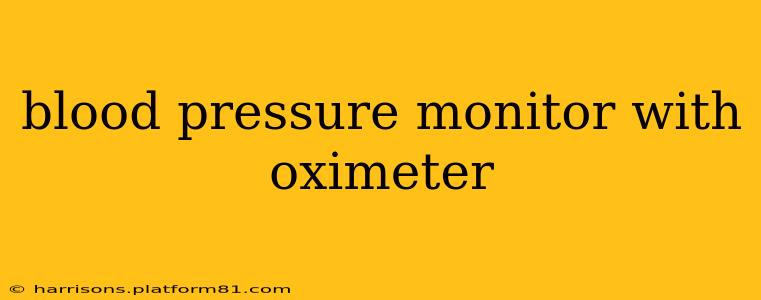Monitoring your blood pressure and oxygen saturation levels is crucial for maintaining overall health and well-being. A combined blood pressure monitor with oximeter offers a convenient and efficient way to track both vital signs simultaneously, providing a more complete picture of your cardiovascular health. This comprehensive guide explores the benefits, features, and considerations when choosing a blood pressure monitor with an integrated oximeter.
What is a Blood Pressure Monitor with Oximeter?
A blood pressure monitor with an oximeter is a device that measures both your blood pressure (systolic and diastolic readings) and your blood oxygen saturation (SpO2). Blood pressure indicates the force of your blood against your artery walls, while SpO2 measures the percentage of oxygen-carrying hemoglobin in your blood. Combining these measurements provides valuable insights into your cardiovascular and respiratory health. This dual functionality is particularly beneficial for individuals with respiratory conditions like COPD, or those recovering from illness or surgery where monitoring both parameters is essential.
How Does a Blood Pressure Monitor with Oximeter Work?
The blood pressure measurement typically uses oscillometric technology, which detects pressure changes in the cuff as it inflates and deflates. The oximeter uses a sensor, usually a clip placed on your fingertip, that employs light absorption technology to determine the SpO2 level. The device then displays both readings on a digital screen, providing a clear and immediate understanding of your vital signs.
What are the Benefits of Using a Blood Pressure Monitor with Oximeter?
- Comprehensive Health Monitoring: Simultaneous measurement of blood pressure and SpO2 provides a more complete picture of your health status than monitoring either vital sign in isolation.
- Early Detection of Problems: Changes in both blood pressure and oxygen saturation can be early indicators of various health issues, allowing for timely intervention.
- Convenience: A combined device eliminates the need for two separate monitors, simplifying the monitoring process.
- Peace of Mind: Regular monitoring offers peace of mind, especially for individuals with pre-existing conditions.
- Improved Management of Chronic Conditions: For those with chronic respiratory or cardiovascular diseases, regular monitoring allows for better management of their conditions.
What are the Different Types of Blood Pressure Monitors with Oximeters?
While the core functionality remains the same, blood pressure monitors with oximeters differ in several features:
- Wrist vs. Upper Arm Monitors: Wrist monitors are more portable but may provide less accurate readings than upper arm monitors, particularly for individuals with irregular heartbeats.
- Display and Memory: Some models feature larger displays, more memory for storing readings, and data connectivity for transferring data to smartphones or computers.
- Additional Features: Some advanced models offer features like irregular heartbeat detection, pulse rate monitoring, and averaging of readings.
How Accurate are Blood Pressure Monitors with Oximeters?
The accuracy of a blood pressure monitor with an oximeter depends on several factors, including the quality of the device, proper usage technique, and the individual's physiology. It’s important to choose a reputable brand and follow the manufacturer's instructions carefully for optimal accuracy. Regular calibration and maintenance can also help to ensure accuracy over time. Always consult with your healthcare provider for accurate diagnosis and treatment.
What Should I Look for When Choosing a Blood Pressure Monitor with Oximeter?
Consider these factors when selecting a device:
- Accuracy and Reliability: Look for models with high accuracy ratings and positive user reviews.
- Ease of Use: Choose a monitor with a clear display and simple instructions.
- Features: Decide which features are most important to you, such as memory capacity, data connectivity, and additional monitoring capabilities.
- Portability: If portability is a concern, consider a wrist monitor.
- Price: Prices vary widely depending on features and brand.
Can I Use a Blood Pressure Monitor with Oximeter at Home?
Yes, many blood pressure monitors with oximeters are designed for home use. However, it's crucial to follow the manufacturer's instructions carefully and understand the limitations of home monitoring. Home readings should be considered as supplemental to professional medical evaluation.
Are Blood Pressure Monitors with Oximeters Covered by Insurance?
Coverage for blood pressure monitors with oximeters can vary depending on your insurance provider and your specific health needs. Check with your insurance company to determine your coverage.
Conclusion
A blood pressure monitor with oximeter provides a valuable tool for comprehensive health monitoring, offering convenience and insights into your cardiovascular and respiratory health. Choosing the right device involves careful consideration of accuracy, ease of use, features, and individual needs. Remember that while home monitoring is convenient, it's essential to consult your healthcare provider for diagnosis and treatment. Regular monitoring, combined with professional medical guidance, empowers you to take control of your health and well-being.
